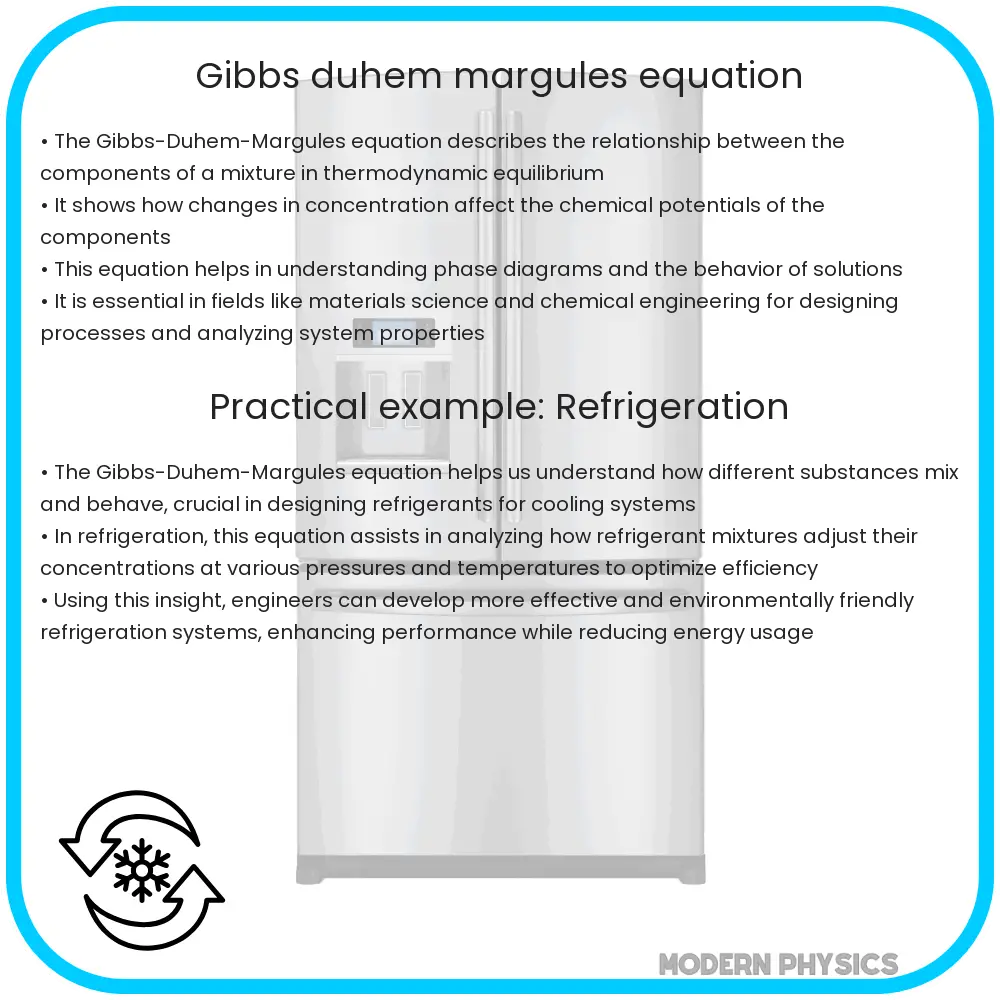Explore the Gibbs-Duhem-Margules Equation: its theory, applications in various industries, limitations, and modern computational insights.

Understanding the Gibbs-Duhem-Margules Equation
The Gibbs-Duhem-Margules (GDM) equation is a fundamental concept in thermodynamics and physical chemistry, offering deep insights into the behavior of mixtures and solutions. This equation describes how the chemical potentials of components in a mixture vary with composition at constant temperature and pressure.
Basic Theory
At its core, the GDM equation is derived from the Gibbs-Duhem equation, which states that the sum of the changes in the chemical potentials of all components of a system, multiplied by their respective molar fractions, is zero. The Margules extension incorporates activity coefficients, providing a more accurate representation of real solutions, especially those that deviate from ideal behavior. Mathematically, the GDM equation can be expressed as:
dμ1 = – (n2/n1) dμ2, where μ represents the chemical potential and n the number of moles of each component.
Applications in Industry and Research
The GDM equation finds numerous applications in both industrial processes and academic research. One significant application is in the study of binary solutions, where it helps to understand the interactions between different molecules and how these interactions affect the solution’s properties. For instance, it is crucial in designing separation processes like distillation, where the relative volatility of components is a key factor.
In the pharmaceutical industry, the GDM equation aids in the formulation of drug solutions, ensuring compatibility and stability of the active ingredients. It also plays a role in food science, particularly in understanding the behavior of mixtures like emulsions and gels.
Deepening Insight with the GDM Equation
The GDM equation is not just a theoretical construct but a practical tool that offers deeper insight into the molecular interactions within mixtures. By analyzing these interactions, scientists and engineers can predict and manipulate the behavior of solutions, leading to more efficient industrial processes and innovative solutions in various fields.
Understanding the GDM equation requires a grasp of concepts like chemical potential, activity, and activity coefficients. These concepts form the backbone of the equation and are critical in applying it effectively in real-world scenarios.
Advanced Concepts and Limitations
The Gibbs-Duhem-Margules equation, while powerful, does have its limitations. It assumes constant temperature and pressure, which might not always be applicable in dynamic systems. Furthermore, the equation is more accurate for binary or simple mixtures. Complex mixtures with multiple components may require advanced modifications or different theoretical models for precise analysis.
Another advanced aspect of the GDM equation is its role in understanding phase equilibria. It helps in calculating the phase diagrams of mixtures, which are essential in materials science and chemical engineering. These diagrams illustrate the conditions under which different phases (like solid, liquid, gas) of a mixture are in equilibrium, providing valuable insights for designing industrial processes.
Computational Aspects and Modern Research
With the advent of powerful computational tools, the application of the GDM equation has become more sophisticated. Computational chemistry and molecular simulations use the equation to predict the behavior of mixtures under various conditions, aiding in the development of new materials and processes. Additionally, ongoing research often focuses on extending the equation to more complex systems and understanding the molecular basis of the interactions in mixtures.
Environmental science also benefits from the GDM equation. It’s used to model the behavior of pollutants in the atmosphere and in aquatic systems, contributing to more effective strategies for environmental protection and sustainability.
Conclusion
In conclusion, the Gibbs-Duhem-Margules equation is a cornerstone in the understanding of mixture behavior in thermodynamics and physical chemistry. Its applications span across industries, from pharmaceuticals to environmental science, offering critical insights into the behavior of solutions and mixtures. While the equation has its limitations, particularly in complex systems, it remains an essential tool for scientists and engineers. Ongoing research and computational advancements continue to expand its applicability and precision, making the GDM equation a subject of enduring relevance and importance in the scientific community.
